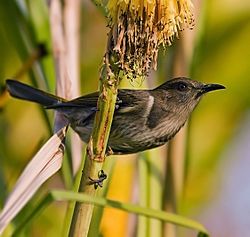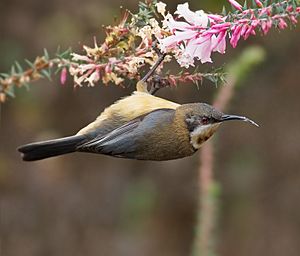Honeyeater facts for kids
Quick facts for kids Honeyeaters |
|
|---|---|
 |
|
| Female crescent honeyeater, Phylidonyris pyrrhopterus | |
| Scientific classification | |
| Kingdom: | |
| Phylum: | |
| Class: | |
| Order: | |
| Suborder: | |
| Superfamily: |
Meliphagoidea
|
| Family: |
Meliphagidae
|
Honeyeaters are a big group of small to medium-sized birds. They mostly eat nectar from flowers. You can find them mainly in Australia and New Guinea. They also live in New Zealand and many Pacific islands, like Samoa and Tonga. One type of honeyeater even lives on Bali.
The scientific name for the honeyeater family is Meliphagidae. This family includes the Australian chats (Epthianura) too. There are 182 different species of honeyeaters in 42 groups called genera. About half of these species live in Australia. Many others are found in New Guinea. Even though honeyeaters look like other nectar-eating birds, such as sunbirds, they are not closely related.
Honeyeaters and Australian flowering plants work together. Many Australian plants rely on honeyeaters to help them make seeds. This is especially true for plants like Proteaceae, Myrtaceae, and Epacridaceae. Honeyeaters are also very important for plants in New Zealand. Scientists think they are just as important in other places too.
Contents
What Do Honeyeaters Look Like?

Honeyeaters are different from hummingbirds in America. Hummingbirds often hover (stay in one spot by flapping their wings fast). Honeyeaters usually do not hover. But smaller honeyeaters might hover for a short time to get nectar.
Most honeyeaters move quickly from branch to branch. They stretch or hang upside down to reach flowers. Many honeyeaters have a special brush-tipped tongue. This tongue is covered with tiny bristles. These bristles help them soak up liquids easily. They quickly flick their tongue into a flower. Then, they close their bill to squeeze out the nectar.
What Do Honeyeaters Eat?
Besides nectar, almost all honeyeaters eat insects. They often catch insects while flying. Sometimes, they pick insects off plants. A few larger species, like the white-eared honeyeater, look for insects under tree bark. The strong-billed honeyeater in Tasmania does this too.
Many honeyeaters also eat fruit. A small number eat a lot of fruit. This is common in tropical rainforests and dry scrubland. The painted honeyeater loves to eat mistletoe. Most honeyeaters, however, mainly eat nectar and insects. Honeyeaters with long, thin bills tend to eat more nectar. Those with shorter bills eat less nectar. Even nectar specialists like the spinebills eat extra insects. This gives them more protein when they are raising their young.
Where Do Honeyeaters Travel?
Scientists do not fully understand how honeyeaters move around. Many honeyeaters follow where their favorite food plants are blooming. Species that live in dry areas seem to travel farther. Their movements are also harder to predict. Birds in more fertile areas do not travel as much. It seems there is no single rule for how honeyeaters move.
See also
 In Spanish: Melifágidos para niños
In Spanish: Melifágidos para niños

